During winter, construction workers must prioritize safety due to slippery conditions and cold weather. Awareness of cold-related health risks is vital. Regular warm-up breaks, effective lighting, and ice-treated surfaces are essential. Ensuring machinery is prepared for winter conditions is also crucial. Proper training and adherence to safety protocols can greatly reduce winter-related risks on construction sites.

Managing Construction Sites During Winters

The Cold Reality
Winter conditions not only bring physical challenges but also affect the mental well-being of construction workers. Shorter daylight hours of winter can impact mood and alertness, which are crucial for safety on a construction site. Moreover, working in extreme cold can lead to quicker fatigue, making tasks that are normally straightforward more difficult and increasing the risk of accidents. Employers must consider these factors in their winter safety strategies.
Additionally, providing training on recognizing the signs of cold stress, such as frostbite and hypothermia, is critical. By taking a holistic approach to winter safety that addresses both physical and mental aspects, employers can maintain a productive, safe, and healthy work environment even in the toughest winter months.

OSHA Competent Person Fall Protection Class
Master vital fall hazard recognition and compliance skills, and become an OSHA-recognized competent person in workplace safety.

Facing Winter Hazards
Construction workers confront a range of winter dangers:
- Icy Surfaces: Frozen ground and black ice turn worksites into potential hazards, leading to slips, skids, crashes, and falls.
- Reduced Dexterity: Cold weather stiffens fingers and hands, impairing the handling of tools and equipment.
- Poor Visibility: Shorter days and foggy or snowy conditions reduce visibility, making it harder to recognize fall hazards.
- Condensation and Ice on Safety Glasses: Safety glasses can fog up or accumulate ice, impairing vision and increasing the risk of missteps and falls.
- Hypothermia: A constant threat, hypothermia can set in quickly, jeopardizing workers’ well-being.
- Decreased Alertness: Discomfort from the cold can distract workers, increasing the risk of accidents, mainly when operating heavy machinery.
Winter-Specific Safety Tips for Construction Workers
As winter approaches, the construction site transforms, bringing with it new risks and challenges. It’s crucial for construction workers to adapt their safety practices to these changing conditions.
Creating a Safe Construction Site in Winter
- Education: Train workers to recognize and address cold weather hazards, equipping them with knowledge and awareness.
- Site Inspections: Regularly inspect the site for potential hazards, addressing issues like snowdrifts and debris.
- Equipment Maintenance: Ensure machinery, tools, and vehicles are winter-ready, following manufacturer-recommended cold-weather practices.
- Dress Appropriately: Workers should wear cold-weather gear, including gloves, boots, and layered clothing.
- Proper PPE: Emphasize the importance of personal protective equipment, including hard hats, safety shoes, goggles, and earmuffs.
- Heating Stations: Set up heated break areas for warmth and encourage regular breaks and warm beverages.
- Emergency Preparedness: Keep emergency and first aid kits readily available, along with flashlights, to respond to accidents or power outages.
- Weather Monitoring: Keep a close eye on weather reports, providing workers with the information they need to stay safe.
- Emergency Shelters: Consider building safety shelters with essentials in open work-spaces.
OSHA Competent Person Fall Protection
Learn critical skills in fall protection, hazard recognition, and safety to qualify as a Competent Person in workplace safety.
Upcoming Classes
English Class
Date: Feb 29, 2024
Time: 8:30 AM to 2:30 PM
Spanish Class
Date: January 26, 2024
Time: 8:30 AM to 2:30 PM

Location
11000 SW Barbur Blvd, Ste 100 Portland, OR 97219








